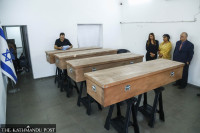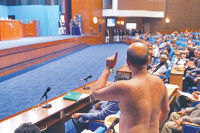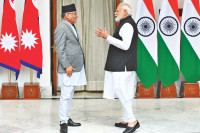Money
Yearender 2022: Let’s turn ‘Pokhara Street Festival’ into one of the world’s most exciting festivals
Industry insiders describe the level of investment in Pokhara as ‘unprecedented’, all the while worrying about whether foreign visitors will increase in the near future.
Deepak Pariyar
On January 1, Nepal will officially open a new international airport in Pokhara, the gateway to the Annapurna region in the Himalayas, one of Nepal’s most popular trekking destinations.
The $216 million facility is located at Chinnedanda, three km east of the existing domestic airport, and will be Nepal’s third international hub after Kathmandu and Bhairahawa.
The construction of the new airport took five years and five months to complete.
The new facilities, if promoted well, would revitalise tourism in the area which has been trying to pick itself up since the Covid pandemic. In 2019, Pokhara welcomed nearly 400,000 international tourists but come 2020, and Covid put a complete stop to all arrivals.
After three years of uncertainty, the new infrastructure has become all the rage at the moment for its potential to revive the tourism sector.
When the government flagged off the construction of the new airport, it wasn’t only Pokhara that rejoiced, the neighbouring districts also became enthused with the prospects of new opportunities the airport brought.
With a large number of infrastructure construction projects—from resorts to cable car networks to adventure sports facilities—the Gandaki Province as a whole has been pushing for change.
Pokhara was a favourite destination among Western hippies during the 1960s and 1970s, and they were the first explorers to visit the Annapurna region.
Mt Annapurna I (8,091 metres) was climbed on June 3, 1950, by French national Maurice Herzog and a team of mountaineers. Since then Pokhara has reigned as the gateway to the Annapurna region. However, its struggle to shrug off its tag of being the “cheapest destination” for decades continues.
Today Pokhara folks are longing for the old heydays when business bloomed making way for hundreds of modern hotels and restaurants employing a large number of people. The Covid pandemic brought unprecedented challenges for the tourism industry and Pokhara, which had always seen a significant footfall of international tourists, faltered.
Although the empty hotels and resorts saw an influx of domestic tourists in the aftermath of the pandemic, the number alone would not sustain Pokhara’s burgeoning tourism industry.
However, moving forward, Pokhara rather than dwelling on the last couple of years of stagnancy has dusted itself off and has prepared for its annual festival—Pokhara Street Festival—celebrated on the eve of the New Year.
Stakeholders believe this festival could be a big draw to attract foreigners and prolong their stay. With strategic branding, the festival can be marketed as other well-known festivals organised by countries around the world. The Pokhara Street Festival can be envisioned and fashioned after famous carnivals such as the Carnival of Venice, Rio Carnival, Boryeong Mud Festival, Oktoberfest, La Tomatina, Albuquerque International Balloon Festival and other globally recognised festivals.
Bikash Bhattarai, a restaurant owner, recalls Lakeside-based restaurants closing down with the arrival of December with foreign tourists normally leaving Nepal to celebrate Christmas and New Year in their homeland.
“December-February is considered an off-season for Pokhara because of the cold weather. Lakeside would also become deserted because tourists would leave for India’s coastal states like Goa and Bangkok in Thailand to celebrate the holiday season,” said Bhattarai.
“I still remember closing our restaurants for two to three months during winters,” recalls Bhattarai.
The scenario is different now, says Bhattarai.
“The street festival has changed that. We are able to keep tourists, who return from treks, in Pokhara, for the festival,” said Bhattarai, who is also the general secretary of the Restaurant and Bar Association (REBAN) Pokhara Chapter.
Despite the pull of the festival, the number of international tourists staying back in Pokhara during the winter months has not seen the desired increase anticipated by the travel industry in Pokhara.
REBAN has been organising the Street Festival at Lakeside for the past 24 years. This year, the Pokhara Street Festival is being held from December 28 to January 1.
The festival with the theme “Eat in the streets, Enjoy in the streets” is held within a three-kilometre area at Lakeside. Vehicles are prohibited from the designated area from Fishtail gate to Jarebar.
The restaurants participating in the festival will serve national and international cuisine on the sidewalks. Various cultural programmes, dances, and exhibitions will also take place at different venues. Lakeside is currently decorated by ensigns put up by restaurateurs, shopkeepers, and hotel owners on their premises.
The Lakeside area lights up during the evenings and the festivities go a notch higher with live musical performances.
Komagane park, the main venue where the new year is rung in, is filled with different attractions like food stalls, clothing stalls, and attractions for children. During the afternoons, guests can enjoy Lok-Dohori programmes too.
Cultural programmes, exhibitions, national and international cuisine showcases, Dohori competitions, cultural parades, night concerts, boat races, open veteran tennis competitions, waiter races, tug-of-war, and documentaries about famous destinations of Pokhara are some of the events featured in the festival.
Mothers’ groups of various villages who have run homestays for the promotion of rural tourism prepare local organic cuisines. It has been helping in the development of rural tourism as well as the promotion of typical Nepali cuisines such as millet bread, and momo among others.
It has worked as a bridge to connect the tourism of the city and the village.
Mothers’ groups from various pockets of Pokhara are supporting the festival. They prepare various indigenous food items using traditional cooking methods and utensils.
In addition to local food, visitors can choose from a variety of cuisines such as Indian, Chinese and Continental. Restaurants and food stalls are offering attractive offers and discounts at the festival.
Besides being a foodie’s paradise, Pokhara Street Festival also showcases one of the big cultural events in the country with Nepali art and culture on display.
The festival has developed as a place for domestic tourists and young students to understand Nepali art culture and for foreigners to get a closer look at Nepal and the ways of its people.
The organisers have been conducting promotional campaigns in various cities across Nepal and outside the country to promote the festival.
Cultural parades of Gurung, Magar, Bhujel, Tharu, Kirat, Newar and other communities are also organised during the festival. The festival visitors also enjoy dancing to Bhajan, Chutka and Panche Baja (a set of five traditional Nepali musical instruments) on the streets.
Ganesh Bahadur Bhattarai, the coordinator of the first Pokhara Street Festival, says the festival was first branded as Lakeside Street Festival in 1998. The following year it was rebranded as Pokhara Street Festival.
“Tourist arrival was almost zero in the month of December prior to organising the first street festival,” said Bhattarai. “The festival becomes the reason for tourists to spend more time in Pokhara.”
During the festival period, hotels and restaurants in Pokhara are fully booked.
The festival not only increases the business of hotels and restaurants but the sales of vegetables, meat, and handicrafts produced by local farmers.
Pokhara has grown and expanded in the last couple of years. The hotels and restaurants that were only centred in the Lakeside area no have expanded to the surrounding hills. This has helped the economy, says Bishwa Raj Poudel, first vice president of REBAN, Pokhara. “Many restaurants that were shut down during the Covid have reopened. There are five-star and chain hotels coming to Pokhara,” said Poudel.
And the new international airport will contribute further in bringing in tourists directly to Pokhara, says Naresh Bhattarai, chairman of the REBAN Pokhara Chapter. “The new international airport will help in keeping tourism afloat in Pokhara. We are eager to welcome tourists from the new facility,” he said.
More than a billion dollars has been invested in the latest flurry of infrastructure development in Pokhara. Industry insiders describe the level of investment in Pokhara as ‘unprecedented’, all the while worrying about whether foreign visitors will increase in the near future.
Will the new level of infrastructure development in Pokhara, once a hotspot of hippies, help the city of lakes become the destination that hosts one of the most amazing street festivals around the world? That depends on how tourism in Pokhara will be marketed after the new airport comes into operation.




 12.12°C Kathmandu
12.12°C Kathmandu.jpg)















